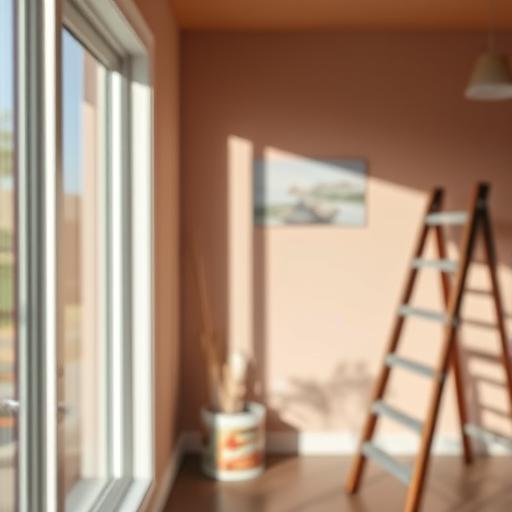Creating a comfortable, livable area in a basement or a modern bunker goes beyond just adding furniture and lighting. These below-ground spaces present unique challenges, primarily moisture and a lack of sunlight, which can wreak havoc on standard wall coverings. Selecting the right type of paint is not just an aesthetic choice; it’s a crucial step in protecting your investment and ensuring the longevity of your space, a job often best handled by professional residential painters Edmonton.
This guide will walk you through the most resilient paint options available for these special environments. We will cover why certain paints excel in damp conditions, how proper preparation is the key to success, and how color can completely change the feel of a room with no windows. Get ready to turn that concrete box into a cozy, protected, and beautiful part of your home.
Why Standard Paint Just Won’t Cut It Below Ground
If you’ve ever seen paint peel, bubble, or develop unsightly dark spots in a basement, you’ve witnessed what happens when the wrong product meets a high-humidity environment. Standard interior paints are designed for the stable, dry conditions of main-floor living areas. Below ground, constant contact with cool concrete walls, potential vapor transmission through the foundation, and general dampness create a recipe for paint failure. 🤢
Durable paints formulated for basements and masonry contain special binders that adhere tightly to concrete and additives that resist the growth of mildew and mold. These formulas are built to handle temperature fluctuations and moisture without breaking down. Choosing a purpose-built paint means you’re applying a protective shield, not just a layer of color, giving you a finish that will last for years.
The Champion of Subterranean Spaces: Epoxy Paint
When it comes to ultimate durability, especially for floors, epoxy paint is in a class of its own. This is a two-part coating consisting of a resin and a hardener, which chemically react to form a tough, rigid plastic coating. The result is an incredibly resilient surface that can withstand heavy foot traffic, impacts from dropped tools, and even vehicle weight, making it perfect for bunker workshops or basement garages.
Beyond its toughness, an epoxy finish is non-porous, meaning spills, oils, and other chemicals can be wiped away without staining. This seamless surface is also a fantastic barrier against moisture seeping up through a concrete slab. While it’s a stellar choice for floors, some formulations can be applied to walls for a super-sturdy, waterproof finish in utility areas or mudrooms.
Your Go-To for Walls: High-Quality Acrylic Latex Paint
For the walls of your basement or bunker, a premium acrylic latex paint is an excellent and accessible choice. Look for products specifically labeled for use in kitchens and bathrooms or those that advertise mold and mildew resistance. These paints contain biocides that inhibit microbial growth, which is a massive benefit in any space prone to dampness.
When selecting your paint, pay attention to the sheen. A satin or semi-gloss finish is a smart pick for subterranean rooms. These sheens are much easier to wipe down than a flat or matte finish, and their slight reflectivity helps bounce light around the room. This simple choice can make a dark area feel brighter and more spacious. ✨
Don’t Forget the Prep Work: The Unsung Hero
The most expensive, high-tech paint in the world is destined to fail if applied to a poorly prepared surface. Before a single drop of paint is applied, your concrete or drywall surfaces must be clean, dry, and sound. This means scrubbing away any dirt, grime, or efflorescence—that white, chalky powder that forms on masonry—and repairing any cracks with a suitable patching compound.
Priming is a non-negotiable step in this process. A quality masonry or waterproofing primer is essential. It serves two main functions: it blocks stains and creates a uniform surface for your topcoat, but more importantly, it acts as a barrier, preventing moisture from passing through the wall and blistering your new paint job. Skipping this step is asking for trouble down the line.
Lighten Up! Using Color to Your Advantage
Basements and bunkers are notoriously dark, so your color choices play a huge role in the atmosphere of the space. To counteract the lack of natural light, stick with colors on the lighter end of the spectrum. Bright whites, soft off-whites, light grays, and pale pastels can make a room feel significantly larger and more inviting.
A great trick to create a sense of openness is to paint the ceiling a pure, bright white or even a shade lighter than your chosen wall color. This draws the eye upward and creates an illusion of higher ceilings. By reflecting the maximum amount of artificial light, these color strategies can help your safe haven feel less like a bunker and more like a cozy, intentional part of your home. 🏠
Ventilation and Curing: The Final, Crucial Steps
Proper airflow is critical when painting any room, but it’s especially important in an enclosed, below-ground area. Use box fans in windows or doorways to exhaust fumes and bring in fresh air. A dehumidifier is also your best friend, as it will pull excess moisture from the air, helping the paint dry and cure correctly.
Remember that “dry time” is different from “cure time.” Paint may be dry to the touch within a few hours, but it takes several days or even weeks to fully harden and achieve maximum durability. Be gentle with your newly painted surfaces during this period. Avoid leaning things against the walls or scrubbing them, as this can easily cause damage to the still-soft paint film.
Maintaining Your Freshly Painted Space
Once the paint is cured and your room is set up, a little regular maintenance will keep it looking great. Keep the air moving and control humidity with a dehumidifier, especially during damp seasons. This is the single best thing you can do to prevent moisture-related problems and preserve the integrity of your paint job.
Every few months, give the walls a gentle wipe-down with a soft cloth and mild soap and water to remove any dust or grime. Periodically check for any new cracks, water stains, or peeling paint, particularly after heavy rains. Addressing small issues as they appear will prevent them from becoming big headaches and ensure your safe haven remains a comfortable and protected space for years to come.


